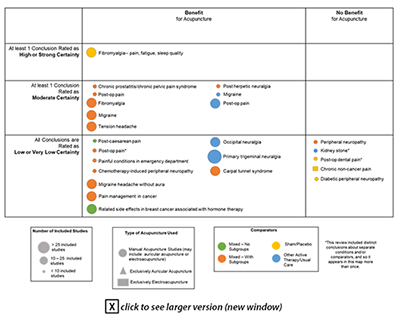» Back to list of all Management Briefs

| Issue 205 | August 2022 | |
|
The report is a product of the VA/HSR Evidence Synthesis Program. Evidence Map of Acupuncture as Treatment for Adult Health Conditions: Update from 2013 - 2021Complementary and integrative health (CIH) options continue to grow in popularity among the general public as well as Veterans. In 2011, the Office of Patient Centered Care and Cultural Transformation (OPCC&CT) was established by VA, and in 2014 leadership launched the Integrative Health Coordinating Center (IHCC) to work to bring CIH approaches to the VA healthcare system. In 2017, the VA Whole Health System of care included acupuncture as one of its CIH modalities, offered in VA’s medical benefits package.
Responding to a request from OPCC&CT’s Integrative Health Coordinating Center, VA’s Evidence Synthesis Program (ESP) Center in Los Angeles, CA conducted this update to provide current evidence regarding the use of acupuncture for adult health conditions of interest to VA. Specifically, investigators sought to provide:
Investigators searched the literature for pertinent systematic reviews, including PubMed, Allied and Complementary Medicine Database (AMED), and the Cochrane Database of Systematic Reviews, which were searched from March 2013 to April 2021. The Database of Abstracts of Reviews of Effects (DARE) was search through 2014, when DARE ceased production. From 1,207 relevant citations, 370 publications were screened as full texts, and 64 reviews were selected for this report. The 64 reviews were categorized into 41 conditions, including headache, back pain, cancer-related pain, depression, and fibromyalgia, among others. The country of origin for reviews varied: China (N = 23), United States (N = 7), Korea (N = 6), Australia (N = 4), United Kingdom (N = 2), Brazil (N = 1), Italy (N = 1), Taiwan (N = 1), and multi-country (N=19). Summary of Findings There is a vast literature of original randomized trials and systematic reviews of randomized trials of acupuncture as a treatment for dozens of health conditions. Based on this literature, study investigators identified several conditions for which the authors of systematic reviews concluded that there is at least moderate certainty of evidence regarding health outcome effects of acupuncture; most of these involve comparisons of acupuncture to sham or control acupuncture. Evidence mapping The evidence mapping process resulted in six visual depictions of the evidence for acupuncture [see full report], with each condition plotted on the map based on the effect of acupuncture and certainty of evidence as reported in the systematic review. General observations from these maps include:
Figure 1. Evidence Map for Painful Conditions, Excluding Musculoskeletal Pain 
Implications for VA Research Gaps/Future Research Studies comparing acupuncture to placebo or sham are probably not the priority; rather the priority should be studies comparing acupuncture to other recommended therapies for the condition. In such studies, the type and schedule of acupuncture treatment needs careful documentation so findings can be applied in other settings. Studies comparing acupuncture to other recommended therapies also should have a sufficiently long follow-up period to allow any non-specific effects (i.e., of getting something “new”) to dissipate. In the nine years covered by this update, investigators identified 370 new systematic reviews of acupuncture. These systematic reviews included about 370 new randomized controlled trials (RCTs) of acupuncture published over the same period of time and are included in the evidence maps. Thus, researchers interested in acupuncture are producing about as many systematic reviews (generally with low or very low certainty of evidence) as new RCTs needed to raise the certainty of evidence. This seems to be a mismatch between resources and need. The field of acupuncture would best be advanced with resources devoted to producing more high-quality RCTs and producing fewer new systematic reviews. Allen J, Mak S, Begashaw M, Miake-Lye I, Severin J, Larkin J, Shekelle P. Evidence Map of Acupuncture as Treatment for Adult Health Conditions: Update from 2013–2021. Washington, DC: Evidence Synthesis Program, Health Services Research and Development Service, Office of Research and Development, Department of Veterans Affairs. VA ESP Project #05-226; 2022. To view the full report, go to vaww.hsrd.research.va.gov/publications/esp/acupuncture-evidence-map.cfm (Intranet only) |
ESP is currently soliciting review topics from the broader VA community. Nominations will be accepted electronically using the online Topic Submission Form. If your topic is selected for a synthesis, you will be contacted by an ESP Center to refine the questions and determine a timeline for the report. This Management e-Brief is provided to inform you about recent HSR&D findings that may be of interest. The views expressed in this article are those of the authors and do not necessarily reflect the position or policy of the Department of Veterans Affairs. If you have any questions or comments about this Brief, please email CIDER. The Center for Information Dissemination and Education Resources (CIDER) is a VA HSR&D Resource Center charged with disseminating important HSR&D findings and information to policy makers, managers, clinicians, and researchers working to improve the health and care of Veterans. |
|
|
This report is a product of VA/HSR&D's Evidence Synthesis Program (ESP), which was established to provide timely and accurate synthesis of targeted healthcare topics of particular importance to VA managers and policymakers –; and to disseminate these reports throughout VA. See all reports online. |
||